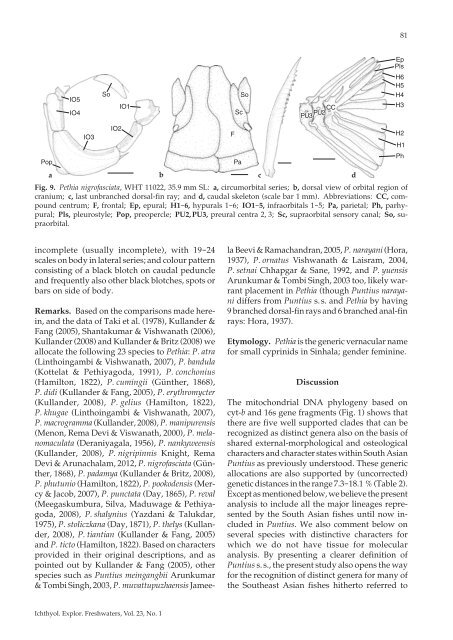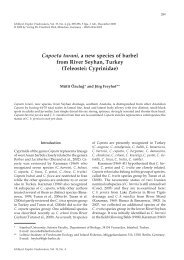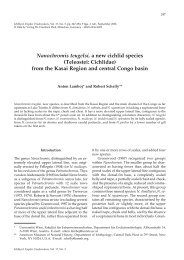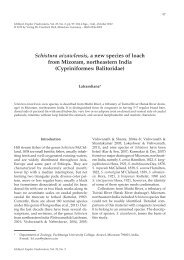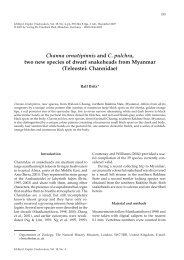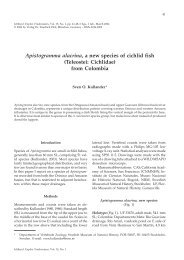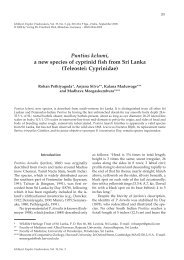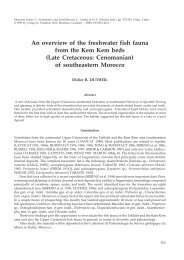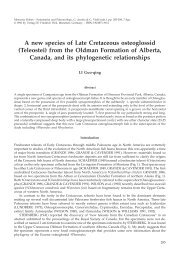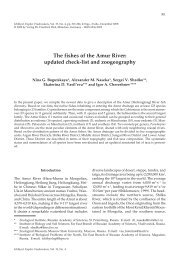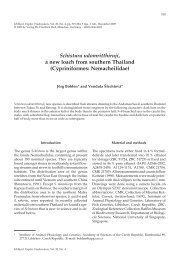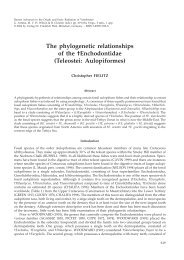A synopsis of the South Asian fishes referred to Puntius - Verlag Dr ...
A synopsis of the South Asian fishes referred to Puntius - Verlag Dr ...
A synopsis of the South Asian fishes referred to Puntius - Verlag Dr ...
You also want an ePaper? Increase the reach of your titles
YUMPU automatically turns print PDFs into web optimized ePapers that Google loves.
Pop<br />
IO5<br />
IO4<br />
IO3<br />
So<br />
IO2<br />
IO1<br />
a b c d<br />
incomplete (usually incomplete), with 19-24<br />
scales on body in lateral series; and colour pattern<br />
consisting <strong>of</strong> a black blotch on caudal peduncle<br />
and frequently also o<strong>the</strong>r black blotches, spots or<br />
bars on side <strong>of</strong> body.<br />
Remarks. Based on <strong>the</strong> comparisons made herein,<br />
and <strong>the</strong> data <strong>of</strong> Taki et al. (1978), Kullander &<br />
Fang (2005), Shantakumar & Vishwanath (2006),<br />
Kullander (2008) and Kullander & Britz (2008) we<br />
allocate <strong>the</strong> following 23 species <strong>to</strong> Pethia: P. atra<br />
(Linthoingambi & Vishwanath, 2007), P. bandula<br />
(Kottelat & Pethiyagoda, 1991), P. conchonius<br />
(Hamil<strong>to</strong>n, 1822), P. cumingii (Gün<strong>the</strong>r, 1868),<br />
P. didi (Kullander & Fang, 2005), P. erythromycter<br />
(Kullander, 2008), P. gelius (Hamil<strong>to</strong>n, 1822),<br />
P. khugae (Linthoingambi & Vishwanath, 2007),<br />
P. macrogramma (Kullander, 2008), P. manipurensis<br />
(Menon, Rema Devi & Viswanath, 2000), P. melanomaculata<br />
(Deraniyagala, 1956), P. nankyweensis<br />
(Kullander, 2008), P. nigripinnis Knight, Rema<br />
Devi & Arunachalam, 2012, P. nigr<strong>of</strong>asciata (Gün<strong>the</strong>r,<br />
1868), P. padamya (Kullander & Britz, 2008),<br />
P. phutunio (Hamil<strong>to</strong>n, 1822), P. pookodensis (Mercy<br />
& Jacob, 2007), P. punctata (Day, 1865), P. reval<br />
(Meegaskumbura, Silva, Maduwage & Pethiyagoda,<br />
2008), P. shalynius (Yazdani & Talukdar,<br />
1975), P. s<strong>to</strong>liczkana (Day, 1871), P. <strong>the</strong>lys (Kullander,<br />
2008), P. tiantian (Kullander & Fang, 2005)<br />
and P. tic<strong>to</strong> (Hamil<strong>to</strong>n, 1822). Based on characters<br />
provided in <strong>the</strong>ir original descriptions, and as<br />
pointed out by Kullander & Fang (2005), o<strong>the</strong>r<br />
species such as <strong>Puntius</strong> meingangbii Arunkumar<br />
& Tombi Singh, 2003, P. muvattupuzhaensis Jamee-<br />
Ichthyol. Explor. Freshwaters, Vol. 23, No. 1<br />
F<br />
Pa<br />
So<br />
Sc<br />
CC<br />
PU3<br />
PU2<br />
Fig. 9. Pethia nigr<strong>of</strong>asciata, WHT 11022, 35.9 mm SL: a, circumorbital series; b, dorsal view <strong>of</strong> orbital region <strong>of</strong><br />
cranium; c, last unbranched dorsal-fin ray; and d, caudal skele<strong>to</strong>n (scale bar 1 mm). Abbreviations: CC, compound<br />
centrum; F, frontal; Ep, epural; H1-6, hypurals 1-6; IO1-5, infraorbitals 1-5; Pa, parietal; Ph, parhypural;<br />
Pls, pleurostyle; Pop, preopercle; PU2, PU3, preural centra 2, 3; Sc, supraorbital sensory canal; So, supraorbital.<br />
81<br />
la Beevi & Ramachandran, 2005, P. narayani (Hora,<br />
1937), P. ornatus Vishwanath & Laisram, 2004,<br />
P. setnai Chhapgar & Sane, 1992, and P. yuensis<br />
Arunkumar & Tombi Singh, 2003 <strong>to</strong>o, likely warrant<br />
placement in Pethia (though <strong>Puntius</strong> narayani<br />
differs from <strong>Puntius</strong> s. s. and Pethia by having<br />
9 branched dorsal-fin rays and 6 branched anal-fin<br />
rays: Hora, 1937).<br />
Etymology. Pethia is <strong>the</strong> generic vernacular name<br />
for small cyprinids in Sinhala; gender feminine.<br />
Discussion<br />
Ep<br />
Pls<br />
H6<br />
H5<br />
H4<br />
H3<br />
H2<br />
H1<br />
Ph<br />
The mi<strong>to</strong>chondrial DNA phylogeny based on<br />
cyt-b and 16s gene fragments (Fig. 1) shows that<br />
<strong>the</strong>re are five well supported clades that can be<br />
recognized as distinct genera also on <strong>the</strong> basis <strong>of</strong><br />
shared external-morphological and osteological<br />
characters and character states within <strong>South</strong> <strong>Asian</strong><br />
<strong>Puntius</strong> as previously unders<strong>to</strong>od. These generic<br />
allocations are also supported by (uncorrected)<br />
genetic distances in <strong>the</strong> range 7.3-18.1 % (Table 2).<br />
Except as mentioned below, we believe <strong>the</strong> present<br />
analysis <strong>to</strong> include all <strong>the</strong> major lineages represented<br />
by <strong>the</strong> <strong>South</strong> <strong>Asian</strong> <strong>fishes</strong> until now included<br />
in <strong>Puntius</strong>. We also comment below on<br />
several species with distinctive characters for<br />
which we do not have tissue for molecular<br />
analysis. By presenting a clearer definition <strong>of</strong><br />
<strong>Puntius</strong> s. s., <strong>the</strong> present study also opens <strong>the</strong> way<br />
for <strong>the</strong> recognition <strong>of</strong> distinct genera for many <strong>of</strong><br />
<strong>the</strong> Sou<strong>the</strong>ast <strong>Asian</strong> <strong>fishes</strong> hi<strong>the</strong>r<strong>to</strong> <strong>referred</strong> <strong>to</strong>


